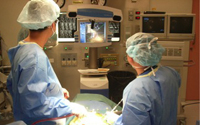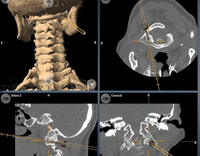902 Specialist Orthopaedic Education
Spine Navigation Surgery - minimally invasive and computer assisted surgery


Spine Navigation Surgery was introduced since year 2000 and adapted in Hong Kong for more than 5 years. Similar technology was widely used in daily activities like driving, computer games (like Wii),etc.. The image-based technology used in spinal surgery utilizes scans of the patient's bony anatomy and instruments that are tracked by the Navigation System's camera. Navigation can help orthopaedic surgeons to guide their instruments for precise screw placement and reduce X-ray exposure.
Spine navigation surgery - Applications
Orthopaedic doctors will undergo proper diagnosis and evaluation before recommendation of surgery. Generally, spine navigation surgery is applicable for common spinal disorders requiring screw placement and especially for areas requiring high surgical precision. For example,
- Revision spine surgery.
- Patients with osteoporotic bones.
- High risk areas like the cervical spine or areas with severe deformities.

Spine Navigation Surgery – Procedures
The first step is to obtain a “map” of the patient’s bony structures in the form of 3D CT scan. The scan’s soft copy is then transferred into the computer and matched to patient’s operating position in the operation room. With the infra-red camera technology, the computer can now track the patient’s and surgical instruments’ positions and shows up in the monitor real-time, multi-planner, motion images.
Spine Navigation Surgery – Pros & Cons
- In the traditional orthopaedic surgeries, screws are placed using freehanded technique or by X-ray guidance, the operation room staffs are exposed to radiation and have to wear heavy lead aprons for protection. Moreover, with the x-ray machine near-by, the surgeons have to operate in a less ergonomic position. With computer navigation, the radiation exposure is reduced and the surgeons are able operate in more comfortable and efficient positions.
- Spine navigation surgery is performed on 3D images that can help orthopaedic surgeons to guide their instruments for precise screw placement especially in difficult areas.
- The matching / calibration process is critical for surgical outcomes and must be performed by experienced surgeons.
- Just like any other advanced technology, computer navigation is a two sided blade. If the sugeons failed to recognize the computer error by continuosly monitoring the anatomical corespondance, it may lead to surgical complications.
The information provided on this website are for educational purposes only. Please consult your physicians before considering treatment or for detailed medical advice.




